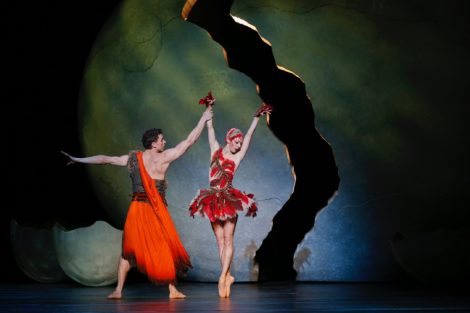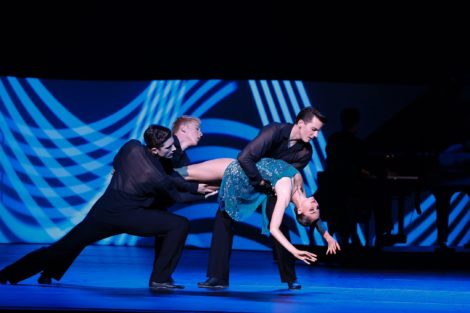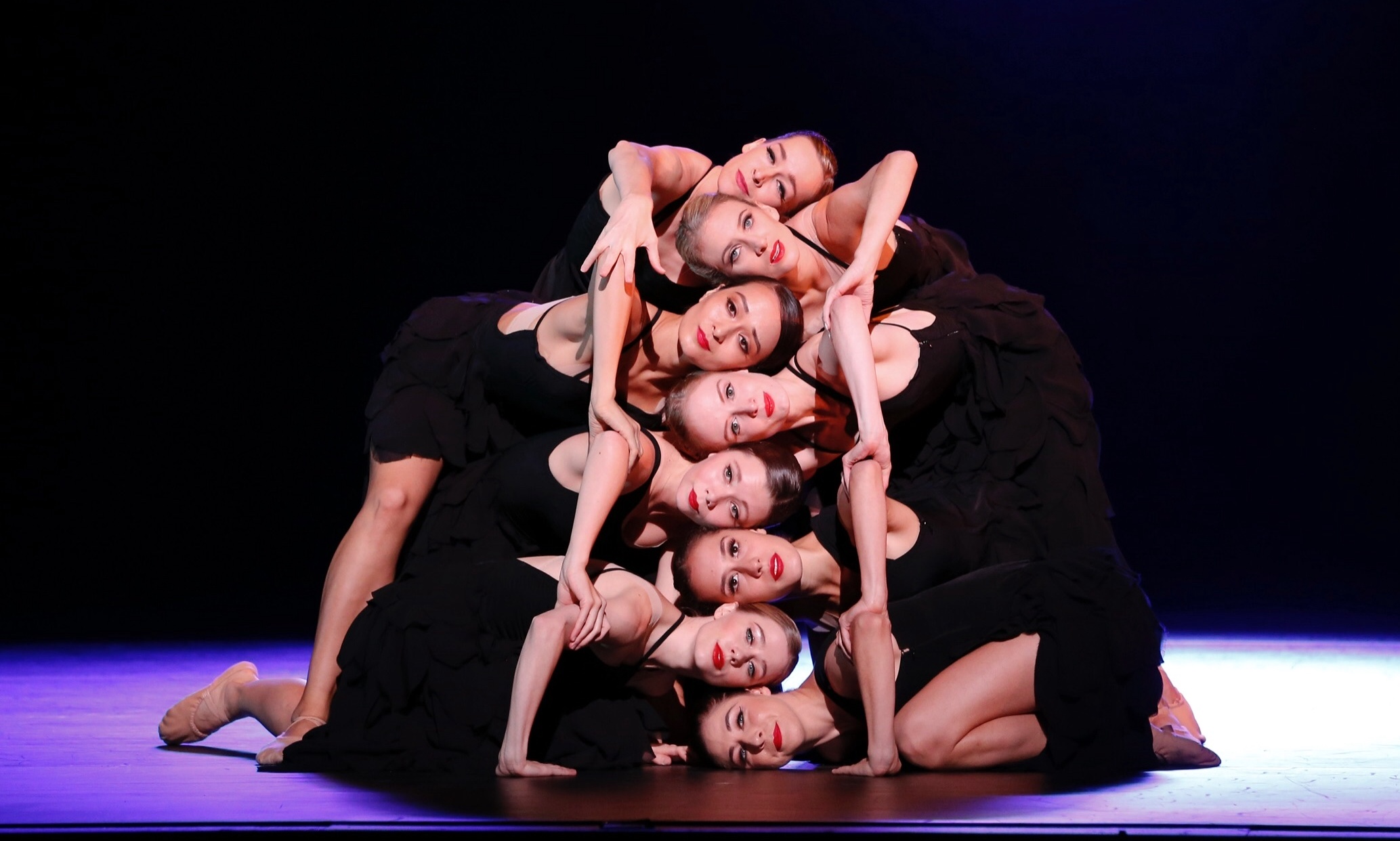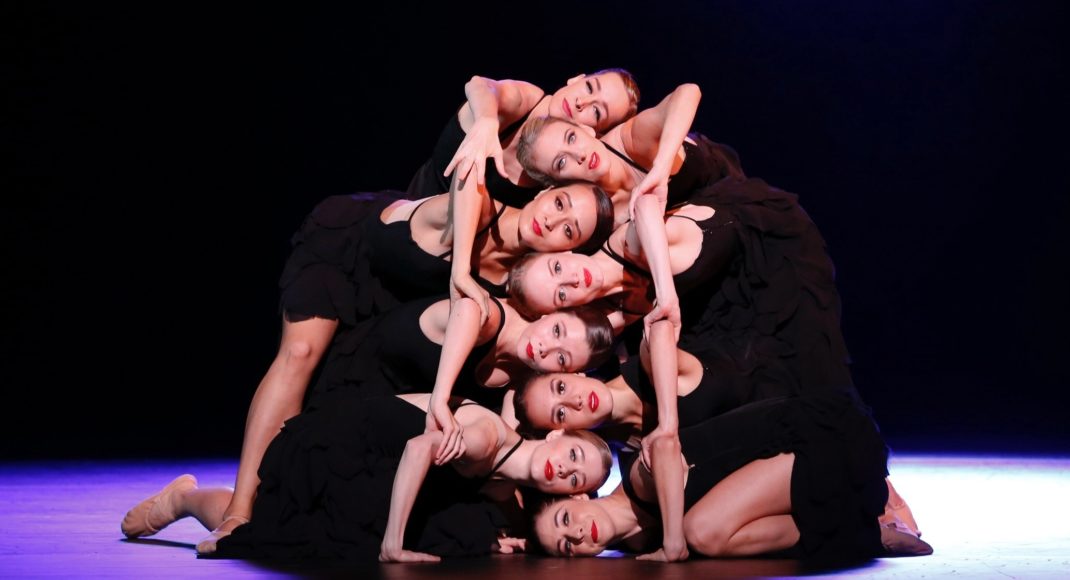16 March 2018. State Theatre, Victorian Arts Centre, Melbourne
This program was a retrospective of works by Graeme Murphy and was in celebration of his long association with the Australian Ballet. The evening began with a brief film clip of Murphy talking about those moments for a choreographer, and by extension for a dancer and for the audience, when a transformation occurs, when a choreographer is able to draw out from a dancer a quality that is artistry at the highest level. The brief interview (a monologue really) was a deeply personal reflection from Murphy and showed his humanity, his humility, his own artistry, and his respect for dance and those who engage with it.
The program that followed was a fine opportunity to ponder on what is distinctive about Murphy’s choreography. It consisted of excerpts from several of Murphy’s works, largely made originally for Sydney Dance Company, and a performance of Murphy’s Firebird, made for the Australian Ballet in 2009. Although Firebird has never been a favourite of mine—somehow it reminds me of a weird cult activity—it was distinguished on this occasion by an exceptional performance from Lana Jones in the title role. Her immersion in the role was complete and her first entrance was stunningly controlled, and believe me the choreographic requirements of that entrance are demanding.

But what emerged as the evening progressed was the diversity of Murphy’s output. His works have humour, but are also often clearly serious in emotional impact; they occasionally cross cultural boundaries; they are always closely connected to music, and his musical choices are themselves diverse; they can be classical in their dance vocabulary, or not so classical as the work demands; they are sometimes narrative-based, at other times quite abstract. Never a dull moment!
What was also fascinating was being able to see some of Murphy’s signature choreographic phrases and groupings across the course of the evening. What stood out for me was the way he uses small groups of dancers, often four, and has them work together as one. Bodies are thrown, swirled, turned upside down, but always engage in a smooth and lyrical manner.
In terms of the works presented, the highlight for me was Grand, the work he made in 2005 in honour of his mother, a pianist. A grand piano onstage was played by Scott Davie (as it was in 2005) and we were treated to several excerpts from this wonderful, funny, emotional work that was strongly musically oriented in so many ways—’sweeping in conception, intimate in detail and constantly surprising in choreographic invention’ I wrote in 2005. It made me long to see the full work again, but it was a treat to see as many sections as we did. They included the delightfully funny Chopsticks section and the Gershwin number, one of those remarkable uses of four dancers who seem to dance as one whatever impossible moves they are asked to make.

The big disappointment of the evening was Shéhérazade, that exquisite short work for two men and two women made by Murphy in 1979. It was performed without the luscious, blue silk tent/canopy with its gold decorative elements, which was such an intrinsic part of Kristian Fredrikson’s designs for the work. Without it most of the mysterious and erotic quality of earlier performances was lost, as was the allusion to the art of Viennese painter Gustav Klimt, and the over-ridingly blue and gold colour scheme that Fredrikson imagined (and achieved). Those hanging strips of what looked like tinsel at times were quite out of place. Just before the work’s opening in 1979 Murphy told a journalist: ‘One of the fascinating aspects of this work will be the design inserted into the dancing. In a sense the dancers will be wearing the set.’ Not this time!
Having said that, however, the standout performance of the entire evening came from Lana Jones as the second of the female dancers in Shéhérazade. Jones’ technique was impeccable. But it was her beautiful attention to choreographic detail that grabbed my attention. Those moments when she moved her wrists in little twisting circles, while holding her hands and arms close to her slightly curved body were breathtaking, as was the way she moved her neck and chest at times. And how spectacular she looked in those iconic poses for all four dancers, which mark certain stages of the work.
The evening belonged to Graeme Murphy and I salute him for all those works that have thrilled us over the years. But bouquets to Lana Jones for two standout performances during the evening. She had it all, and I thought she was dancing not just choreography but Murphy’s choreography.
Michelle Potter, 18 March 2018
Featured image: artists of the Australian Ballet in Grand, 2018. Photo: © Jeff Busby


This review appreciated, thank you — and triggers memories of Murphy’s exquisite Orpheus for RNZBallet as part of Harry Hayhtorne’s Stravinsky Celebration, 1982.
Helen Booth was Eurydice, sucked swiftly away under a silk curtain, a blink and you missed that. If you did see her go, you won’t have forgotten it. Murphy has always been a master of timing.
I have real regret that RNZB has not commissioned more work from Murphy over the years.
I found an interesting handwritten document amongst Kristian Fredrikson’s papers at the National Library of Australia. He was writing about how designs for dance might be created so that they expressly enhance or influence choreography. He wrote specifically about RNZB’s Orpheus, which he and Murphy worked on together. He said that the translucent kimono he designed for Eurydice was ‘factored into the pas de deux’ and then eventually became ‘a cocoon, and finally a shroud in which the angel of death drags Eurydice to the underworld.’
Yes, ‘dragged’ is the word … or ‘vortexed’…
She was there and then she was gone…
We saw her go before Orpheus did …
Never forgotten it.
They were both so good at creating and using such things, and working them into the choreography, which is why it was extremely annoying that the Sheherazade canopy wasn’t there.
It was indeed wonderful to see Lana Jones at the top of her game. Others: Brett Chynoweth gets more and more fabulous every time I see him dance and he was well-matched by young Drew Hedditch in the Air and Other Invisible Forces trio, Dimity Azoury’s Marschallin was very well-acted, Valerie Tereshchenko in the Gershwin section of Grand, and Kevin Jackson must have arms of steel – when he carried Leanne Stojmenov in for the Beethoven section of Grand, her eye makeup had blurred presumably due to the eye-watering position she was in, yet Jackson’s arms (binoculars yay) held her rock-steady for what seemed like forever. Special mention for Victoria Lambourn’s beautiful singing in Shéhérazade, with a tiny note that (beautifully unamplified) singers require possibly a slightly quieter orchestra than do dancers, if they’re not to be drowned out.
I was so pleased I didn’t take my mum this time, as the scene shown from The Silver Rose was the one during which she loudly remarked “That’s so unnecessary” (the only time she’s ever spoken during a ballet performance we’ve attended together since 1970)!!
I thought it interesting (peculiar) how little had originally been created for TAB in what was supposed to be a celebration of Murphy’s 50 years “with The Australian Ballet” (according to TAB’s website): only Firebird. Off the top of my head, I can suggest half a dozen pieces commissioned by the company: Beyond Twelve, Nutcracker (Clara), Romeo and Juliet (pretty much all of which is signature Murphy, therefore we did get most of it in the show we were given), Gallery (another, early, Fredrikson collaboration), Swan Lake, Tivoli…with the added bonus that the gorgeous balcony scene from R&J hardly requires scenery, just those beautiful stars…the pdd for Beyond Eighteen and First Love…the final elegiac part of Beyond Twelve…Tivoli has some parts just as fun as the “cowboy hoedown” we were given from Ellipse and the Fats Waller part of Grand…
The evening also seemed unbalanced, with the excerpts from Grand alone approximately the same length as the whole Firebird, in fact the first “half” was about 80 minutes, the second just over 30. Perhaps rearrange the order, with a couple of the shorter pieces moved to after the interval, or have Silver Rose and the other shorter excerpts, a 15-minute interval, Grand, another 15-minute interval, then Firebird.
I was sorry to see only one performance, as Andrew Killian, whom I feel to be well-suited by the Murphy repertoire, was not dancing on the one night I was able to go.
Goodness what a lot to say…but it’s all personal, ballet-watching, isn’t it?
Great to hear from you Anna, and yes, it is all personal, which is good and which is why I love comments like yours!
I wanted to write my post about Graeme Murphy since the program was about him, although I simply couldn’t leave Lana Jones out. And I didn’t mention that amazing moment when it came to curtain calls and it was Lana’s turn to call Graeme from the wings to receive the audience’s response. Instead of rushing up to him she moved towards him and then stood a little away from him and made a deep curtsey. It was a beautiful moment of respect from dancer to choreographer. Then she went up to him and led him to centre stage for his well-deserved standing ovation (a real one with everyone standing). But that aside, you have filled in so much more about the program and the dancers. Thank you.
I have seen several comments about the balance of the program. To tell the truth I would have loved to have seen Grand in its entirety and fewer of the shorter excerpts. Some were clearly selected to make the audience laugh and smile (which they did and which is fine) but most mean more when seen within the entire work. But I agree wholeheartedly that the program needed more from works that were made specifically for the Australian Ballet. Something from Tivoli would have been welcome given that it was initially a joint Sydney Dance and Australian Ballet production, quite aside from the fact that it was a great show. And you would be surprised (or perhaps not) how many dancers and others, including one former artistic director, speak about Gallery with pleasure and admiration. It is always hard to know, however, what criteria are used in program selection (and who was involved in this particular case).
I’m looking forward to seeing the show in Sydney with, I am expecting and hoping for, a different cast.
Thank you Michelle! I will have to talk to the one of my sisters who, envious of my brother and myself having a joint subscription and even he (a never-before-ballet watcher who initially bought the subscription as his present for my 50th and threw in his company as an extra) enjoying the last two years, finally bought her own subscription but for a couple of shows has different nights from us. She attended opening night and I will try and carve a few minutes from her week to discuss.
I would not be at all surprised to hear positives about [i]Gallery[/i], as I myself remember it fondly.
Sadly I have no hard information regarding the criteria or responsibility for choices, my gossip network is failing me these days – although I do know three of the seven couples cast as Camille and Valencienne in the upcoming [i]Merry Widow[/i]! There are seven principal casts altogether with three cities in which to perform, so by the time it gets to Melbourne it will most likely be a case of who is left standing, and there may yet have to be eight or even nine variations.
All that aside, the only other thing I wanted to say about this programme is that it was nice to see some opportunities being given to dancers who appear perennially overlooked. One in particular last seems to have had an opportunity in 2012.